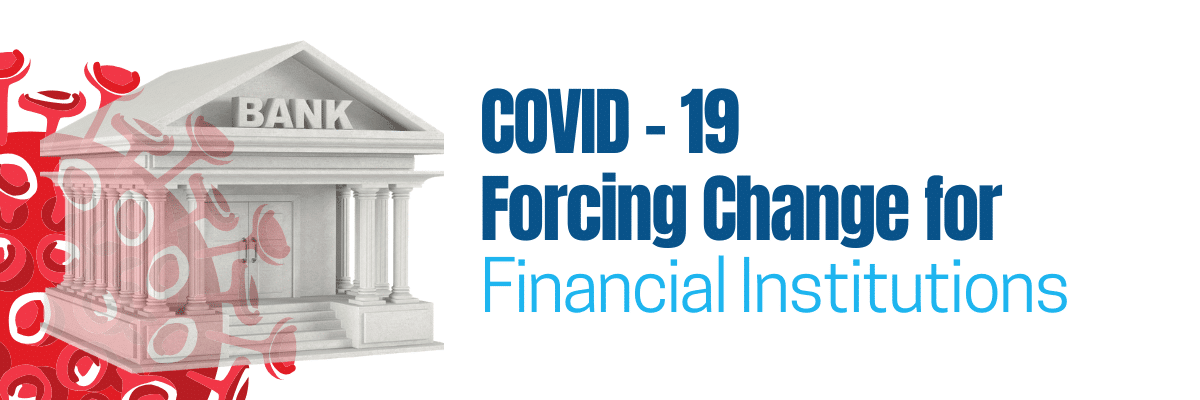
The COVID-19 pandemic has forced industries around the world to reshape how they do business. Daily operations and business processes have been impacted by the shift to remote, online work. One industry that is especially dependent on supplemental in-person interactions is banking and finance.
To understand the effects this pandemic is having on the industry and determine how financial institutions can combat them, we sat down with our very own Bruce Switzer, Banking and Financial Services Principal, and Marty Gulewicz, Banking and Financial Engagement Manager, to talk about what they are seeing within the banking and financial landscape since COIVD came into play.
Q1) Marty, Bruce, as you work alongside some pretty big banks, how are you guys seeing COVID-19 affect the financial landscape?
Bruce Switzer
“One of the significant ways that COVID is affecting banking is the impact of employees not being able to work at the bank. These organizations can’t do things the way they used to when employees were in the office. It’s created a whole new set of challenges in banking.
Some challenges include lower interest rates and increased lending volumes with higher default risk, which reduces revenues. At the same time, transaction volumes are down due to global liquidity and lending supply narrowing, which leads to lower fees collected from transactions. You can see that the financial services industry is facing significant declines in market capitalization.

This situation drives home the need for automation in the banking industry going forward. It’s a great learning opportunity because business processes that rely on people and manual intervention are being impacted, and banks must determine how to adjust.”
Marty Gulewicz
“It’s changed the way consumers interact with financial institutions. You can’t go in and open an account today like you used to, you can’t go in and get information from the bank like you used to. Today financial institutions are looking for a way to open accounts, share information with their customers, and get information back from their customers. They don’t have the same level of interaction that they used to have before COVID.”
Q2) Do you foresee any lasting effects because of COVID-19?
 Marty Gulewicz
Marty Gulewicz
“Right now, financial industry employees who are working remotely are bringing up multiple challenges. They’re figuring out how they can support customers without branch access. They’re struggling to engage customers from their homes. They may not have access to necessary information files. They have to keep up compliance and productivity, all while figuring out how to best do their jobs from home.
Despite these challenges, financial institutions are going to have to rely on technology more and more after this as the world and the workplace becomes more digital. Workforces are going to be more geographically dispersed; you’re going to see more and more people working remotely. Because of that, you’re going to see a big reduction, there won’t be nearly as many people employed by financial institutions in the future.
This shift to digital interactions is forcing banks to reinvent customer relationships. Without face-to-face interaction, banks must leverage technology to give customers the same consistent experience.
I think the traditional banks are going to be slower to adapt though. Ultimately they’re going to win because they have the resources at their disposal, but in the beginning, it’s going to be some of those smaller financial institutions that are going to get a leg up because they have learned to be more nimble during this time. It’s going to be an interesting ride that will significantly transform operations within the industry.”
Bruce Switzer
“That is a resounding yes. It may never be ‘business as usual’ again. The economy that follows this pandemic could potentially lead to permanent structural change on the supply-side and/or demand-side of banking, which will drive lower commerce and lending flows.
Unfortunately, the next potential COVID situation is right around the corner, and, going forward, this is going to make banks and financial service companies stronger. Particularly those that take advantage of some of today’s technologies to totally automate their business processes and drive out the reliance on manual effort.
For traditional banks this is a wake-up call to take advantage of technologies that are available to help them address COVID and COVID-like situations. Well-established banks are going to find ways to compete more effectively with the Fintech uprising.”
Q3) How would you say financial institutions are currently dealing with the pandemic?
 Marty Gulewicz
Marty Gulewicz
“For banks right now, cash is king. COVID is causing them to rethink how budgets are being allocated. What we see our clients doing is putting a lot of their cash reserves on hold and pushing them out until the third, fourth quarter, maybe even first quarter of next year, because they’re not sure where the money needs to be spent at this moment since the future is so unpredictable. Because COVID has changed the way that they do business, they’re trying to see where they can best spend that money the second half of the year.”
Q4) Do you have any advice on what banks can be doing right now to combat the negative effects of COVID-19?
Marty Gulewicz
“The one thing I would recommend is to look at your processes. Right now, you’re learning where your processes may be broken or inefficient, whether that’s in opening accounts, onboarding a new customer, even setting up a product or service. The customer needs to know that they’re being taken care of, that they’re needs are being met.
So, I would advise any of our clients to look at your processes to determine how you can best meet your customer’s needs. You may have to adjust or revamp processes and reorganize your employees based on the changes. Your current processes worked well when you had a lot of human interaction along the way, but now that that human interaction is being stretched, you’re seeing that there are some chinks in the armor, and the customer is being hit the most by it.”
Bruce Switzer
“What’s key right now is for banks and financial services to take an extremely proactive outreach approach to their customers. Now more than ever be very proactive and have your employees reach out and make sure your clients understand that you’re there for them, that you’re doing everything possible, that you want to do everything possible during this challenging time. You should be overcommunicating with the customer as appropriate, especially with high-value business clients.”
Q5) How can automation help financial institutions? What automation technologies would you recommend?
Bruce Switzer
“There are a variety of technologies banks can evaluate to address the shortfalls of manual interactions with business processes that serve their customers. One technology is robotic process automation (RPA), which is the ability to build software robots that essentially replace tedious, manual, repetitive tasks that we still see quite a bit of in banks and financial services companies. RPA can help combat inefficient processes within an organization by automating simple tasks and freeing up employees to complete higher-value work.
We’ve also talked about the importance of the customer relationship and the importance to overcommunicate and reach out and be proactive, and that can only be done if a bank or financial services company has a good understanding of that customer. So, I would highly recommend an organization to implement technologies around the concept of case management or the idea of having all the information about your customer in one place.
With case management technology, you can communicate effectively and with confidence and understanding of the relationship between the customer and the bank. If I was going to point to one area of business process automation going forward, besides RPA, I would definitely point the organizations towards evaluating a case management type of technology.”
Marty Gulewicz
“Each organization is going to be slightly different; some organizations are farther along in the journey than others. So, the big wins for them are going to be robotic process automation to take over a lot of those essential tasks that don’t add value. One thing we’re seeing during the pandemic, and we’ll probably see after it ends, is a rise in call volumes and communication from customers. Automated bots can help address these communications more efficiently, so employees have time to do work instead of field customer questions.
The other thing to look at is their cloud strategy. With remote workers now becoming the norm, if they haven’t already thought about it, now is the time to determine where they want to take their cloud strategy. Some organizations have embraced it and others are hesitant about it. But because of this new world order and the remote workforce, cloud strategy is going to become very critical for these institutions.”
Ensuring positive customer experiences and interactions is part of the daily operations of any financial institution. But now It’s even more important to provide your customers with good experiences—especially now that most of those interactions have become digital and your processes may not be equipped to handle it or you may be limited by remote employees.
Banking and financial services companies that lack the technology to continue providing their customers with good interactions and experiences are hurting the most during COVID-19. Automation can help these institutions overcome some of the negative effects they’re currently dealing with. Implementing these technologies now will not only help with this crisis but will help companies be better prepared for the workplace’s shift to remote work.
Though robotic process automation and case management are two of the main automation technologies discussed by our experts, you can learn more about automation technologies through these on-demand IBM webinars that explain their digital automation platform.
If you want to learn more about RPA and how it can be leveraged in banking, download our on-demand webinar ‘Treasury Management: Empowering Digital Workers with RPA’. We partnered with Aite Analyst group to host this webinar on how RPA can help empower your team to drastically cut down processing times and provide a better experience for clients.
